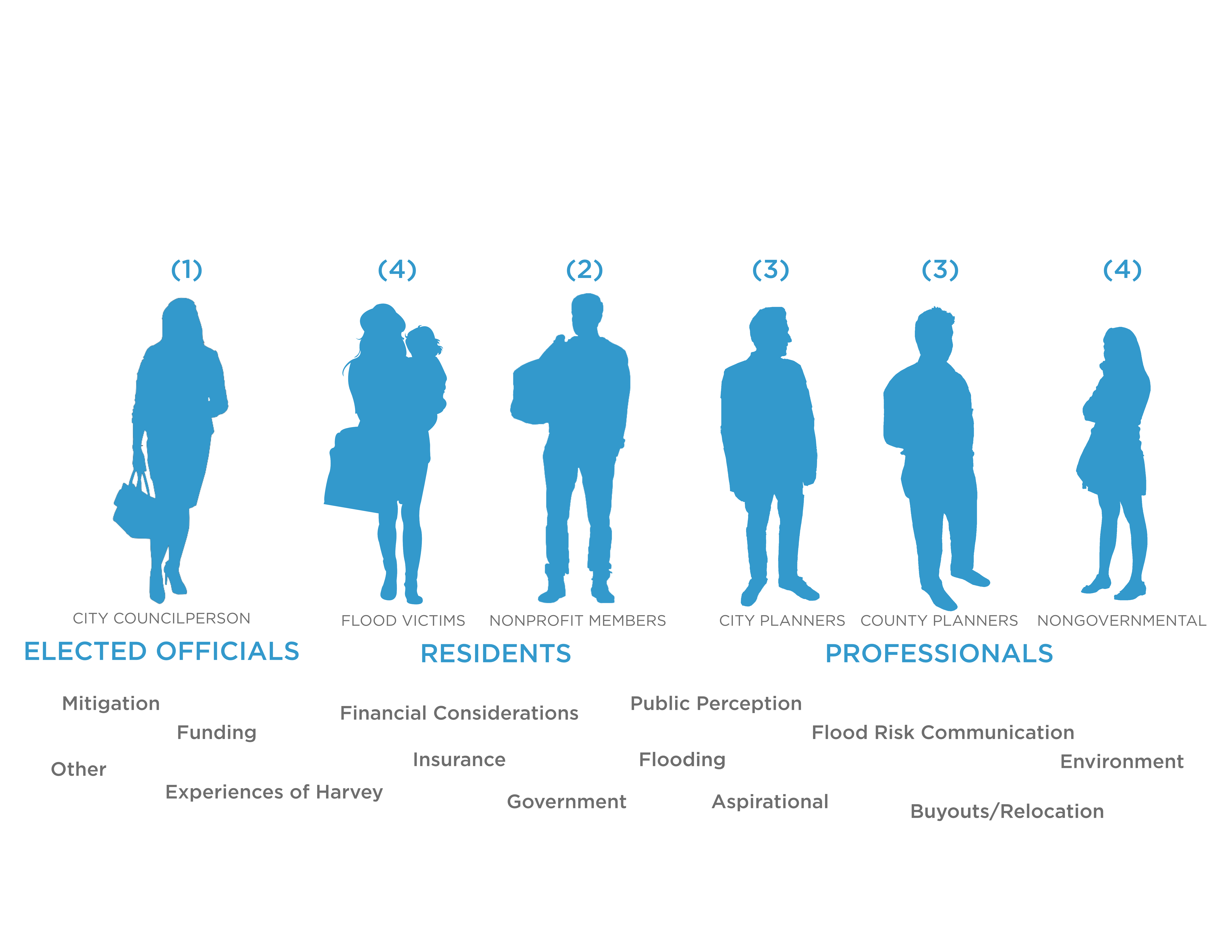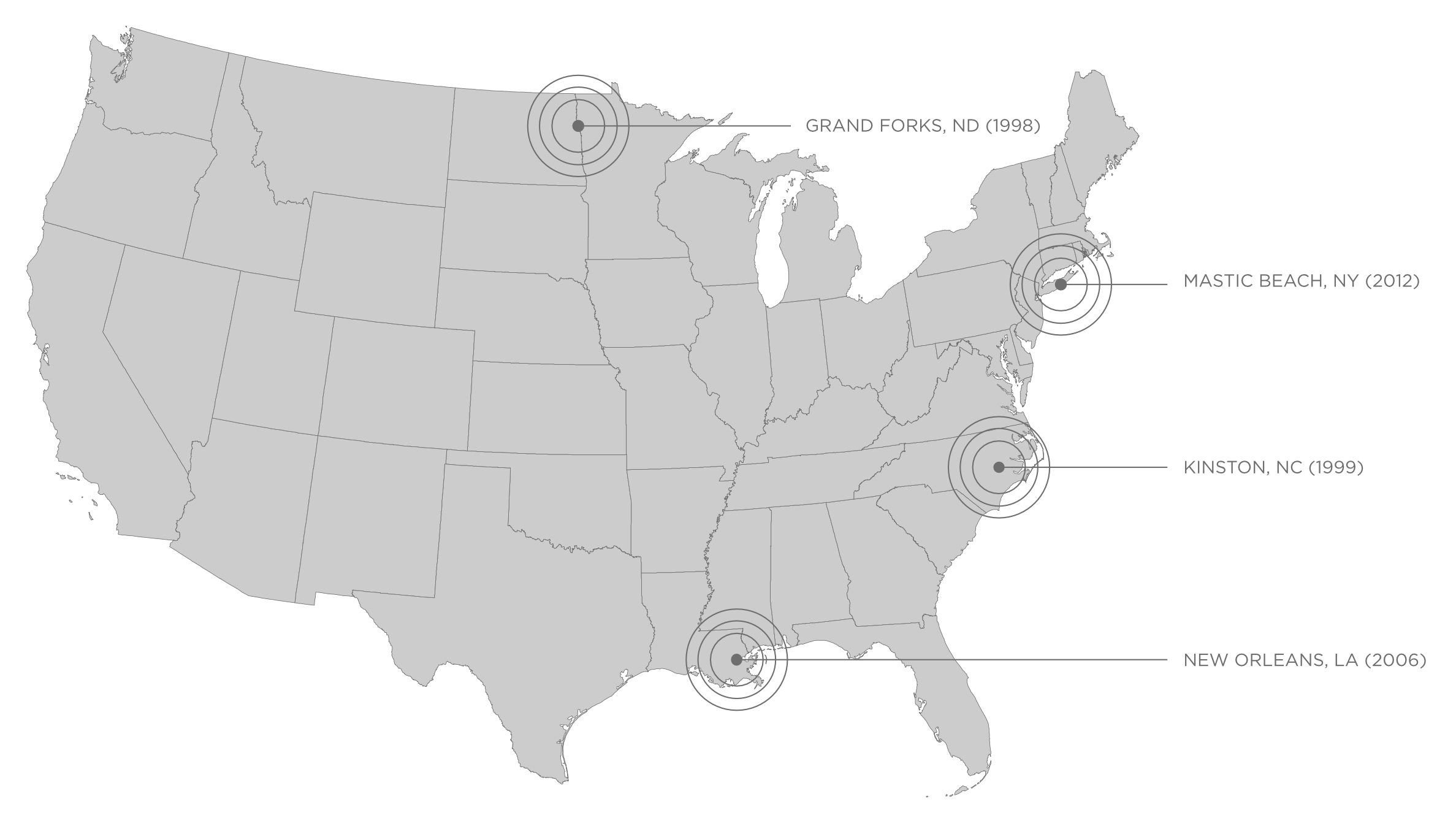3 Methods
A closer look at land acquisitions, particularly US federally-funded buyouts, as a flood mitigation strategy in the post-catastrophic flooding context will best illustrate the need for this integration of flood hazard mitigation strategies into local land use planning. The structure of this investigation utilizes grounded theory methodology,26, 27 using a mixed methods approach structured into two parts: a Case study and a Precedent review.
Case Study
The case study subject is Houston, TX post-Hurricane Harvey. Initial background research included a review of online newspaper articles, both local and national, cataloging the recovery of the city. Through that review, I recognized a recurring theme of buyouts, particularly a strong discussion about the role and scope of buyouts for Houston post-Harvey. Essentially, there are strong and reaffirming opinions that Harvey should be the impetus for massive buyouts in the city to best mitigate so much of the impacted and increasingly at-risk development.
Where and how buyouts are implemented is heavily dependent upon where and how flooding occurs and the existing local government structure that would administer the buyout program. Thus, I overviewed the flooding history of Houston, TX. This was supplemented with researching the nature of flooding and the diversity in the experience of flooding within the metropolitan area. The causes of flooding are then linked to the existing buyout program in the region, which has its own history and criteria for eligible properties. Harvey’s impact contributes to how extreme weather events in the face of climate change put a strain on existing processes, thus demonstrating the problem for Houston, and other cities, face when considering the possibilities for increased acquisitions as a flood mitigation strategy.
Interviews
I also conducted interviews in Houston from January 7th to January 20th, 2018 to better capture in situ perspectives on the topic. Interviews were semi-structured using an interview guide28 and lasted up to an hour. Topics of the interview included:
- Flooding issues in the city of Houston,
- What effect Hurricane Harvey has had and will continue to have on future flood management efforts in the city, and
- The effectiveness of relocation as a flood mitigation strategy for Houston, TX.
The purpose of the interviews, broadly, were to document perspectives on relocation out of the flood- prone areas across different stakeholders in Houston, TX, and this information is then situated in the ongoing debate over the role of buyouts in the recovery of Houston.
The general goals for sampling was to interview Houstonians that would fit into one of three broader categories of:
- Residents
- Professionals, i.e. citizens whose career engaged with flood management in Houston (city planners, floodplain specialists, civil engineers, etc.)
- Elected Officials (Mayor, City Councilpersons, County Commissioners, etc.)
An initial contact list was drafted through research and supplemented with snowball sampling methodology. Ultimately, 17 individuals were interviewed with at least one from each of the broader categories (see figure 1). I took an inductive, open-coding approach to analyzing the interview transcripts and notes, connecting them to the larger public debate surrounding buyouts in Houston and the discussion of integrating hazard mitigation into local land use planning. Given the low sample number, the data collected does not stand for representativeness for any specific group, but it does allow a comparative look at available perspectives and concerns across groups as well as connections to the greater discussions of buyouts in a post-Harvey Houston and beyond.

Figure 1
Precedent Review
Informed by a review of available literature, a set of criteria for buyouts/land acquisition programs conducted at the city-scale was crafted in order to select precedent examples for further examination. To also further narrow the scope, out of all the development challenges created through using buyouts and/or land acquisitions as a flood mitigation strategy, I focused on the issue of replacement housing for units acquired and demolished. Through this focus, this research highlights how planning, which already has mechanisms for creating housing units, can contribute to issues of housing affordability, availability and safety in the context of flood hazards informing development. The criteria was as follows:
- Within the United States, as to have a uniform governmental structure
- Implementation pre- or post- flood disaster as a mitigation strategy
- The concurrent development of or programmatic connection to new or existing housing for buyout/ acquisition participants
Four precedents were chosen: Grand Forks, ND, Kinston, NC, New Orleans, LA and Mastic Beach, NY (see figure 2). Each precedent case was distilled into a matrix for comparative analysis looking at 1. When and how the flooding occurred, 2. What were the motivations to pursue buyouts and/or land acquisitions in conjunction with other housing development, 3. How buyouts and/or land acquisitions were pursued in conjunction with other housing development and 4. Whether or not the pursuit was successful. Success was defined as participants of the buyout/acquisition programs fully transitioning into the designated housing. The ways in which these precedents uniquely addressed the challenges for integrating hazard mitigation into local land use planning serve as prompts for both the practice of planning and cities like Houston to also overcome the challenges using tools and resources already available but applied to hazards context.

Figure 2
26 Barney G. Glaser and Anselm L Strauss, “Discovery of Substantive Theory: A Basic Strategy Underlying Qualitative Research,” American Behavioral Scientist 8, no. 6 (1965).
27 George Allan, “A critique of using grounded theory as a research method,” Electronic Journal of Business Research Methods 2, no. 1 (2003).
28 H. Russell Bernard, Research Methods in Cultural Anthropology (Newbury Park, California: Sage, 1988), “Unstructured and Semistructured Interviewing”, 204-5.